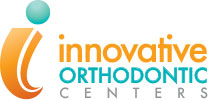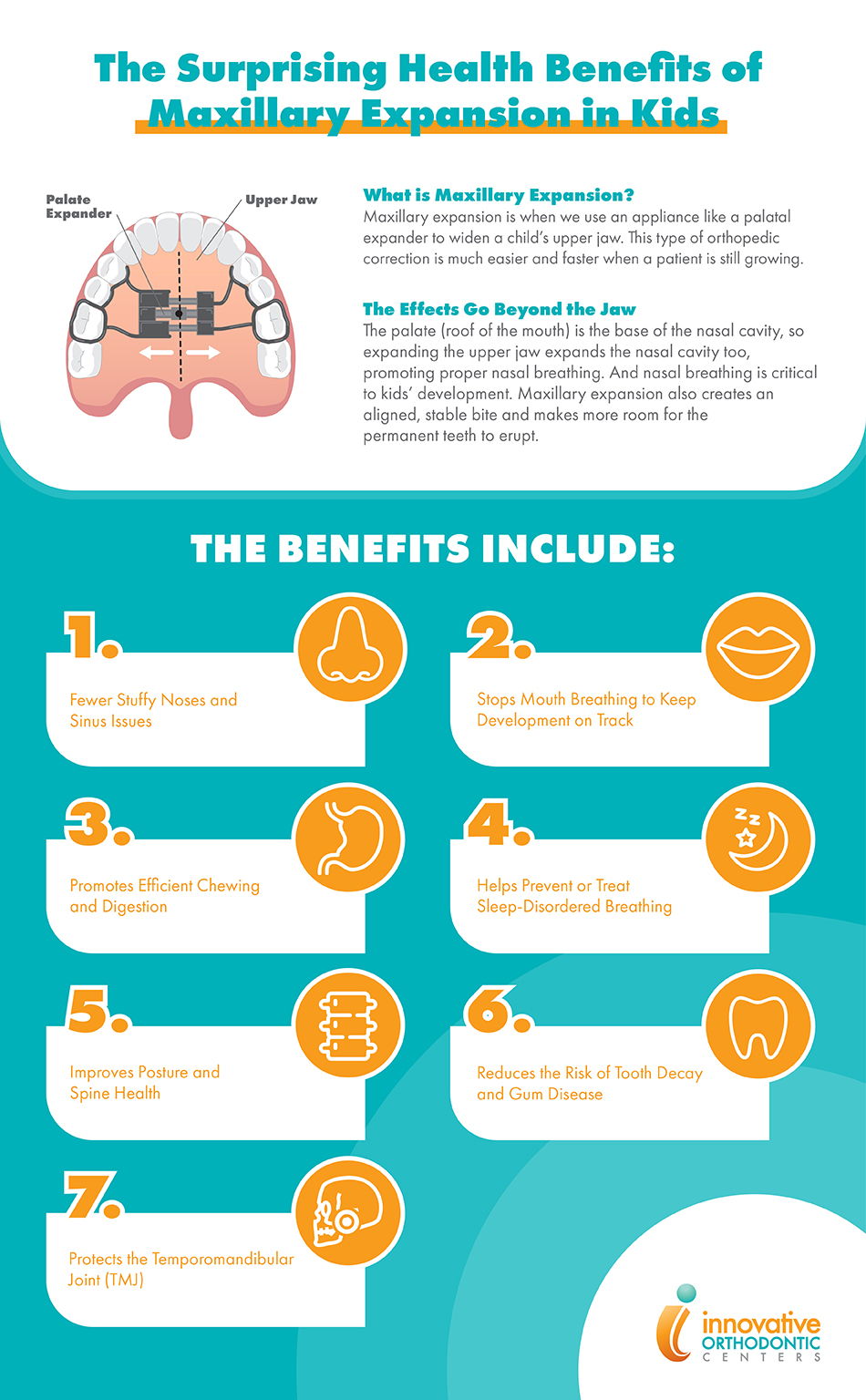Even a few decades ago, most kids started orthodontic treatment after they’d lost all of their baby teeth, usually around age 13 or so. Since then, diagnostic technology and treatments have evolved along with the research. Orthodontists like Dr. Manal Ibrahim and Dr. Christine Gin can now see when a child has an emerging orthodontic concern much earlier and intercept the problem.
Using certain orthodontic appliances, they’re able to guide a child’s jaw growth and make room for the permanent teeth to erupt in their proper places. This can help children avoid the need for jaw surgery or extractions down the road and make later treatment with braces or Invisalign® Teen easier and faster.
One instance where early orthodontic treatment could be recommended is when a child’s upper jaw is too small. Not only does a small or narrow upper jaw often cause a crossbite and/or severe crowding, but it’s also tied to airway obstruction and other issues.
In fact, expanding the upper jaw, which is called maxillary expansion, can have some serious health benefits for kids.
The Anatomy of the Upper Jaw
The maxilla is the bone that forms the upper jaw and a portion of the hard palate (roof of the mouth). It also serves as the floor of the nasal cavity. The maxilla is actually made up of two halves that meet in the middle of the palate at what’s known as the midline suture. These two maxillary bones, or maxillae, don’t fuse together until around puberty.
What is Maxillary Expansion?
Maxillary expansion, or palatal expansion, is when we use an orthodontic appliance, such as a rapid palatal expander, to widen the upper jaw. Because the maxillae aren’t fused yet in children, they respond to pressure from the appliance at the midline suture. This pressure causes the maxillae to drift apart. Then, new bone forms in the middle, permanently widening the upper jaw.
When kids have a palate expander, the appliance sits against the roof of the mouth. For the first several weeks, the expander is activated by inserting a key and turning it. Expansion is gradual and, while there might be some mild aching at first, it’s not painful.
How long do kids wear a palatal expander? Generally, it will be in place for six to nine months as part of their phase 1 orthodontic treatment. This is because once the desired amount of expansion is achieved, the appliance stays in place for a while longer to allow newly created bone time to fill in.
Depending on your child and their unique needs, they may have a palatal expander on its own or along with another appliance.
The Health Benefits of Maxillary Expansion in Kids
1. Fewer Stuffy Noses and Sinus Issues
The palate is the floor of the nasal cavity. When kids have a small or narrow upper jaw, they will also have a narrow nasal cavity. This can make it hard to breathe through the nose, especially when faced with a cold or allergies.
Studies, including one published in the International Journal of Pediatric Otorhinolaryngology, show that rapid palatal expansion in growing kids significantly enlarges the dimensions of the nasal cavity. This creates a healthy foundation for the nose and sinuses, helping to prevent nasal obstruction and the congestion and sinus infections that can come along with it.
Being able to breathe properly through the nose also warms and moistens the air, filters out impurities and, as we’ll get to next, plays a role in a child’s dental and facial development.
2. Stops Mouth Breathing to Keep Development on Track
When little ones aren’t able to breathe through their nose, they resort to mouth breathing. Mouth breathing interferes with craniofacial development and is a reason why airway orthodontics has been getting more recognition.
Chronic mouth breathing can cause malocclusion, or an improper bite, further narrowing of the palate and skeletal changes, including a long, narrow face.
One of the major benefits of maxillary expansion is stopping or preventing mouth breathing and encouraging nasal breathing to keep kids’ growth on track. A palate expander creates facial symmetry, which not only enhances a child’s appearance, but also ensures the bones, muscles and joints are where they’re supposed to be for optimal function.
3. Promotes Efficient Chewing and Digestion
Crooked teeth and a misaligned bite can limit the types of foods kids are able to chew, potentially leading to nutritional deficiencies. Additionally, some studies suggest that impaired chewing can cause bloating, stomachaches and other digestive issues.
Palatal expansion is a tried and true way to make enough room for the permanent teeth to erupt and address bite discrepancies early on. Kids will be able to comfortably eat any type of food and chew it well enough to digest it with ease.
4. Helps Prevent or Treat Sleep-Disordered Breathing
Nasal breathing optimizes oxygen absorption by the lungs. Mouth breathing, on the other hand, forces kids’ bodies to jump through hoops to get enough oxygen in the blood. According to research published in Current Trends in Otolaryngology and Rhinology, a consequence of this is sleep-disordered breathing, including snoring, obstructive sleep apnea and upper airway resistance syndrome.
Aside from a narrow nasal cavity and subsequent mouth breathing, a small jaw also doesn’t leave enough room for proper tongue posture, so the tongue has a tendency to sit further back. When a child is relaxed during sleep, the tongue and soft tissues then block the airway, resulting in a temporary cessation of breathing (obstructive sleep apnea).
In any case, sleep-disordered breathing reduces oxygen saturation in the blood and interferes with the quality and quantity of kids’ sleep. Unlike adults who feel tired from lack of sleep, kids tend to get hyperactive.
In fact, sleep-disordered breathing is tied to ADHD in children. It can also cause behavioral problems, learning disabilities, bedwetting, poor school performance and more.
If sleep-disordered breathing isn’t treated and continues into adulthood, heart disease, depression and a host of other illnesses can crop up too.
By helping kids breathe through the nose, giving the tongue enough room and strengthening the chewing system, airway orthodontics with maxillary expansion can stop or prevent sleep-disordered breathing and its negative outcomes.
5. Improves Posture and Spine Health
Another compromise the body makes to get enough oxygen when there’s airway obstruction is adopting a forward head posture. This forward head posture is unconscious, meaning telling a child to sit up straight won’t do much.
Forward head posture stresses the cervical spine (neck), which can cause neck pain, headaches, jaw pain and shoulder pain. It can also result in a pinched nerve and, over time, as the effects of misalignment travel down the spine, lower back pain too.
The cervical spine supports the weight of the head. When the jaw is aligned, it helps to pull the head back and promote good posture. Good posture has a positive impact from head to toe and is a key to spine health.
6. Reduces the Risk of Tooth Decay and Gum Disease
A small jaw might not be immediately evident in a younger child, but once the permanent teeth erupt, there will be upper crowding. Crowded, crooked teeth are harder to keep clean and food debris and plaque tend to collect in the nooks and crannies.
Plaque bacteria release acids when they feed on sugars and starches from food and drinks. These acids wear away tooth enamel and can cause tooth decay. Plaque is also a source of gum disease, or periodontal disease, which is a bacterial infection of the tooth-supporting tissues.
The severe form of periodontal disease, called periodontitis, can spread to the jawbone, causing bone loss and tooth loss, as well as to other areas of the body. Periodontal disease has been tied to a variety of health conditions, including heart disease, Alzheimer’s disease, lung disease and premature birth.
One of the benefits of early orthodontics in general is making room for the permanent teeth to come in with minimal crowding. This is especially true of treatment with a palatal expander. After expansion is complete, there will be a whole lot more room for the teeth and cleaning them will be easier, reducing a child’s risk of tooth decay and gum disease for life.
7. Protects the Temporomandibular Joint (TMJ)
The temporomandibular joint (TMJ) connects the jaw to the temporal bone in the skull. A narrow jaw, mouth breathing and forward head posture all put serious strain on the TMJ and related structures.
When Dr. Ibrahim and Dr. Gin create a treatment plan for a child, they look at things holistically. It’s about more than straight teeth. They ensure the jaw, TMJ, chewing muscles, teeth, lips and facial features will be in harmony. And while the aesthetic benefits and increased confidence kids will gain are important, so are the health benefits that come along with proper alignment.
By protecting the TMJ and chewing system, kids can avoid pain and dysfunction and enjoy improved oral and overall health.
Interested in Orthodontics for Kids in Naperville or Shorewood, IL?
The American Association of Orthodontists recommends kids have their first orthodontic evaluation by age 7. At Innovative Orthodontic Centers, these growth and development checkups are complimentary!
Our team uses state-of-the-art technology and in-depth expertise to assess kids’ teeth, jaw and airway. If early orthodontics with maxillary expansion is needed, Dr. Ibrahim and Dr. Gin will walk you through their findings and recommendations and create a personalized treatment plan for your child. Our goal is a beautiful, confident smile and exceptional health.
Schedule a visit for your child with a Naperville or Shorewood orthodontist today!





